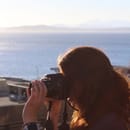After being introduced in 1816 by Nicéphore Niépce, photography has served multiple purposes and has become a favored skill to many. Today, a camera does so much more than capture memories of the past; it creates art. The style of photography has continued to blossom because of the creativity and expression that an artist is able to achieve with their subject. As the years have progressed, cameras have improved and more tools have been created with the intention of easing the photographer’s efforts and allow them to explore more creative uses of the medium. But how have these tools negatively impacted the artistic and traditional values of photography? Today, the digital age has redefined the key elements that shaped the world of photography, distorting the magical aura that pictures originally focused on.
The classification of a photographer has been vastly altered and may as well be defined as, “a person capable of repeatedly hitting a shutter button”– although, many don’t know what the shutter button truly is or how it functions. By this definition, anyone with a camera phone can view themself as apart of the photographic realm. With a digital camera, one can take thousands of pictures in a matter of minutes, and the skill of patience, taught in photography, is completely lost. In the past, people put effort in positioning, angling, and timing the perfect moment to capture the perfect subject. Then there was time dedicated to the film’s developmental process, and if the images turned out poorly or you disliked them, you would have to start all over again. Now, digital cameras can capture as many pictures as you desire, and if you still miss something or have an error, there’s always photoshop.
These technological advancements, though convenient and appreciated, have created a new standard that photographers’ art should be held to. Looking at social media, celebrities share their lives through purposefully chosen images that are deemed flawless. By using filters and photoshop, this change in standards makes it difficult to find beauty in a raw, original photo. Although I’ve been preaching the values of using the traditional film style of photography, for the sake of this next portion, I used a digital camera to compare these images. With the following images, I’ll note the differences between a raw photo, a filtered photo, and a photoshopped photo.
Raw Photo #1
Filtered Photo #1
Raw photo #1 is unedited and is more intimate than Filtered Photo #1 because there is less to distract the viewer. The purple tint flatters the image but makes the situation less realistic. Also, the viewer is able to appreciate the smoke in the photo, highlighting the effort the photographer made to capture it.
Raw Photo #2
Photoshopped Photo #1
Looking at Raw photo #2 the image seems happier and more vibrant while the photoshopped picture has a more omniscient feeling. The angling of the camera makes the viewer focus more on the gum–especially with the bright colors–but when looking at the photoshopped picture, the contrast between the dark and the light takes away from the gum being the main focus.
Although I have been arguing that traditional photography is considered better, there is no truly “correct way”. A true artist uses all their resources to the best of their advantage and usually doesn’t care for criticism. I guess you could say I’m questioning what makes a true photographer, because pressing a button and adding some filters, in my opinion, is not what genuine photography is about. The time and effort that you put into a piece is what makes the art impactful to its audience. Technology and photography are forever changing and evolving. The ability to capture a moment or immortalize beauty is becoming easier and easier, but let’s not discredit the focus, intensity, and artistry that comes from those who study in depth the art of photography.



